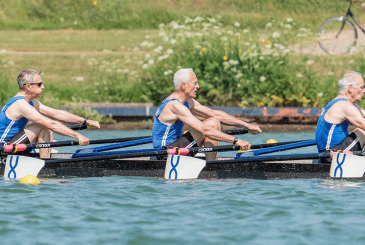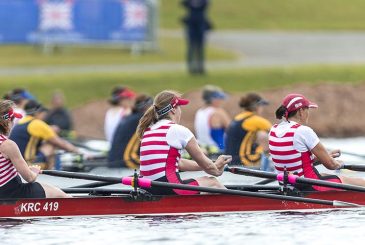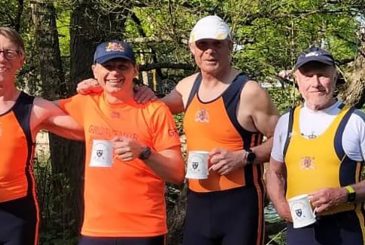In our latest article for masters, Wendy Martinson, Consultant Nutritionist GBRT, shares her research findings on nutritional recommendations for older athletes, highlighting five key areas of health and nutrition to pay special attention to as we age
Congratulations!
If you’re reading this article, the chances are high that you are already engaged in regular physical activity within the rowing community or elsewhere; and the great news is that keeping physically active is one of the most important things we can do to combat the negative impact that ageing has on our bodies. Research shows that at any age, participation in sport results in a 20-40% reduction in all causes of death compared with non-participation, so keep on rowing!
Some of the age-related changes that happen to our bodies over time include loss of muscle and bone mass, an increase in body fat, decreased absorption and utilisation of some nutrients, reduced immunity, changes in gut function, decreased sensitivity to taste, smell and reduced thirst.
But don’t worry all is not lost! Regular exercise and the type of food that we choose can influence these changes and this article will delve a little deeper into this topic and cover five key areas of health and nutrition to pay special attention to as we age.
The limited literature available on the nutrition requirements of ageing or master level athletes is focused mainly on males over 60 years. However, it is possible to make recommendations utilising research available both on younger athlete populations and the impact of ageing on body functions.
1 – Sufficient energy intake for a healthy mind and body
Appetite, taste, and smell can decrease with ageing and issues with dentition can also cause problems with chewing which may impact on the amount of food consumed and overall energy and micronutrient intake. Some medication can also influence absorption or utilisation of nutrients. It’s important to consume enough energy particularly from carbohydrate-rich foods to be able to support training and recovery, maintain a normal weight and an effective immune system. Regular intake of carbohydrate is particularly important because ageing appears to reduce the capacity to store glycogen (carbohydrate fuel) in the muscles which is most likely related to a decrease in type 2 muscle fibres.
Some people not impacted by decreasing appetite may struggle to control their weight as they age and a regular routine including physical activity, consuming plenty of fruit and vegetables, whole grain high-fibre carbohydrates, lean protein foods and avoiding excess alcohol and foods high in fat and sugar can help manage this.
2 – Protein and resistance training to stay strong
During the process of ageing there is a decrease in muscle mass at a rate of ~0.5-2% loss per year from the age of around 50 years depending on the level of physical activity. The degeneration of muscle mass, function and strength that occurs with ageing is referred to as sarcopenia and can lead to problems with mobility, increased risk of falls and a general deterioration in quality of life and independence.
The decrease in the rate of muscle building is reported after ages 40-50 years but can be improved with higher protein intakes
Regular physical activity can help to reduce the decrease in muscle mass and anabolic resistance that occurs with ageing. Anabolic resistance means that the muscle is less sensitive to the stimulus of exercise and protein in terms of switching on its muscle building/repair capacity. Including some strength work as well as aerobic training is a key component in maintaining muscle mass and the sensitivity of the muscle.
A higher intake of dietary protein is needed in athletes compared to the general population. This is to provide enough of the essential building blocks (amino acids) to support the training and adaptation of muscle and body proteins. This also applies to master athletes not only because of the physical activity undertaken, but because of the ageing process which as previously mentioned may impact sensitivity of the muscle to protein.
The decrease in the rate of muscle building is reported after ages 40-50 years but can be improved with higher protein intakes. A suggested target would be 1.6-1.8g protein /kg per day so for a weight of 70kg that would be 112–126g protein per day. The distribution of this protein throughout the day is also key, so that the muscle is stimulated at regular intervals by the amino acids found in protein. The amino acid leucine is of particular importance as it is the trigger for that muscle-building pathway. All meals during the day should ideally contain 0.3-0.4g protein/kg with 3g leucine. Good sources of leucine-rich protein include milk and dairy foods, eggs, meat, fish, poultry, and soya.
Consuming protein immediately after training and one to two hours before bed will help muscle recovery. This is especially important on heavy training days as master athletes generally take longer to recover particularly from endurance exercise than younger athletes.
There may also be some benefit to taking creatine and an omega-3 supplement to help preserve skeletal muscle mass and function.
3 – Look after your gut
Changes can occur to gut function with ageing including decreased intestinal motility (muscle contraction in gut) which may be associated with abdominal discomfort and constipation. Including higher fibre carbohydrate foods such as wholegrain bread, rice, oats, potatoes (with skin), pulses and fruits and vegetables, alongside a good fluid intake can help support healthy gut function.
There can also be a decrease in absorption of certain nutrients with age including vitamins B6, B12, D, calcium, iron, and zinc related to a decrease in function of the gut (gastric atrophy). Vitamin B12 absorption can decrease in 10-30% of people over 50 years.
See the table below for more details.
Nutrient sources and recommended intakes
| Nutrient & recommended intake | Function | Good sources |
| Iron Females: 19-50yrs – 14.8mg/d 50yrs+ – 8.7mg/d Males: 19yrs+ – 8.7mg/day | Required for synthesis of haemoglobin and myoglobin, essential components in transport and delivery of oxygen within blood and to the muscles | Red meat, liver, kidney, shrimps, mussels, sardines, pilchards, fortified breakfast cereals, pulses, egg yolk, nuts, dried fruits and green leafy vegetables, vitamin C (enhances iron absorption) |
| Zinc Females: 19yrs+ – 7.0mg/day Males: 19yrs+ – 9.5mg/day | Involved in immune function, protein synthesis and blood formation | Meat, liver, chicken, oysters, crab & other seafood, whole grains, pulses, nuts, seeds, soy, and dairy products, |
| Vitamin B12 Males & females: 19yrs+ – 1.5µg/day | Coenzyme required for normal metabolism of nerve tissue and of protein, fat, and carbohydrate | Meat, liver, kidney, chicken, fish, shellfish, dairy products, eggs, fortified soy milk and cereals |
| Vitamin B6 Females: 19yrs+ – .2mg/day Males: 19yrs+ – 1.4mg/day | Needed for protein metabolism, forming red blood cells, antibodies & neurotransmitters (brain chemicals) | Yeast extract, wheat germ, fortified breakfast cereal, avocados, bananas, chicken, liver, meat, nuts |
| Vitamin D See bone health section | Needed for calcium absorption, immunity, muscle, bone, and nerve function | Oily fish, egg yolk, fortified food such as low-fat spreads & margarine |
| Calcium See bone health section | Necessary for blood clotting, nerve transmission, muscle stimulation, Vitamin D metabolism and maintaining bone structure | Dairy products, calcium fortified soy milk, tofu, soy yoghurt, green vegetables such as broccoli, spinach and kale, dried figs & apricots |
Supporting the gut microbiome – the collection of gut bugs (virus, bacteria, and fungi) that live in our gut (large intestine) with a variety of fibre-rich fruits and vegetables and a daily probiotic can also help digestion and be good for immunity and the brain.
4 – Protect your bone health
Bone mineral density (BMD) which can be used to predict risk of osteoporosis (weakened bones) and fractures also decreases with age in both men and women. However, weight-bearing exercise (walking, jogging, dancing, tennis, climbing stairs) and strength training can help maintain BMD and reduce the rate of progression. Bone loss occurs earlier around age 45 years and at a faster rate, 1% per year in women compared with men where bone loss commences at around 50 years and continues at a rate of about 0.3% per year thereafter.
You can support bone health by eating sufficient protein and paying special attention to calcium and vitamin D. Ageing decreases the skin’s ability to produce vitamin D through the action of sunlight which coupled with decreased absorption of both vitamin D and calcium increases the requirement for both.
The National Osteoporosis Foundation (NOF) recommends for post-menopausal women and men aged 50 years and older the following intakes for calcium and vitamin D
Calcium – 1000 mg/day for men 50–70; 1200 mg/day for women 51 and older and men 71 and older.
Vitamin D – 800–1000 IU/day, for men and women age 50yrs and older. There are very few food sources of vitamin D, but vitamin D supplements are readily available.
5 – Don’t forget your fluid assets
Ageing athletes are at a higher risk for heat stress, cold intolerance and having a reduced body water content than younger athletes because physiological responses to temperature regulation deteriorate with age. In hot conditions, ageing is associated with a lower cardiac output (the amount of blood the heart pumps in a minute) which decreases blood flow to the skin to remove heat and a decrease in sweat production which reduces the cooling effect of evaporation and increases the risk of heat stress. However, older endurance athletes still retain a better ability to regulate heat than those that don’t exercise. Heat injury risk appears greater in males than female athletes across the life span.
Paying attention to fluid intake particularly in the heat will also help reduce the risk of heat stress
The thirst sensation and therefore fluid intake can also decrease with age and so it is important to plan and monitor fluid intake. A general rule of thumb would be to aim for 35ml per kg per day, plus additional fluid to replace sweat losses which can be estimated by weighing pre and post exercise.
Summary
Many changes occur in the body during the process of ageing and keeping physically active and eating well can help combat these changes. Consuming a higher level of some nutrients such as protein, calcium and vitamin D in both food sources and supplements, if required, is important. A good intake of carbohydrate-rich foods will support training demands and recovery. Paying attention to fluid intake particularly in the heat will also help reduce the risk of heat stress.
Further reading
Cosman, F., et al., (2014). Clinician’s Guide to Prevention and Treatment of Osteoporosis. Osteoporosis international: a journal established as result of cooperation between the European Foundation for Osteoporosis and the National Osteoporosis Foundation of the USA, 25(10), 2359–2381.
Doering, T. M., Reaburn, P. R., Phillips, S. M., & Jenkins, D. G. (2016). Postexercise Dietary Protein Strategies to Maximize Skeletal Muscle Repair and Remodeling in Masters Endurance Athletes: A Review. International journal of sport nutrition and exercise metabolism, 26(2), 168–178.
Louis, J., Vercruyssen, F., Dupuy, O., & Bernard, T. (2019). Nutrition for Master Athletes: Is There a Need for Specific Recommendations? Journal of aging and physical activity, 1–10.
Moore D. R. (2021). Protein Requirements for Master Athletes: Just older versions of their younger selves. Sports medicine, 51(Suppl 1), 13–30.
Public Health England. Government Dietary Recommendations. 2016
Raeburn, P., Doering, T., & Borges N. (2021) Nutrition issues for the masters athletes. In L. Burke, V. Deakin & M. Minehan (Eds.) Clinical Sports Nutrition
Rosenbloom, C. A., & Dunaway, A. (2007). Nutrition recommendations for masters athletes. Clinics in sports medicine, 26(1), 91–100.
Strasser, B., Pesta, D., Rittweger, J., Burtscher, J., & Burtscher, M. (2021). Nutrition for Older Athletes: Focus on Sex-Differences. Nutrients, 13(5), 1409.
Wall, B., T., Cermark, N., M., Van Loon, L., J., C. (2014) Dietary protein considerations to support active aging. Sports Medicine 44 (suppl2), S185-S194










